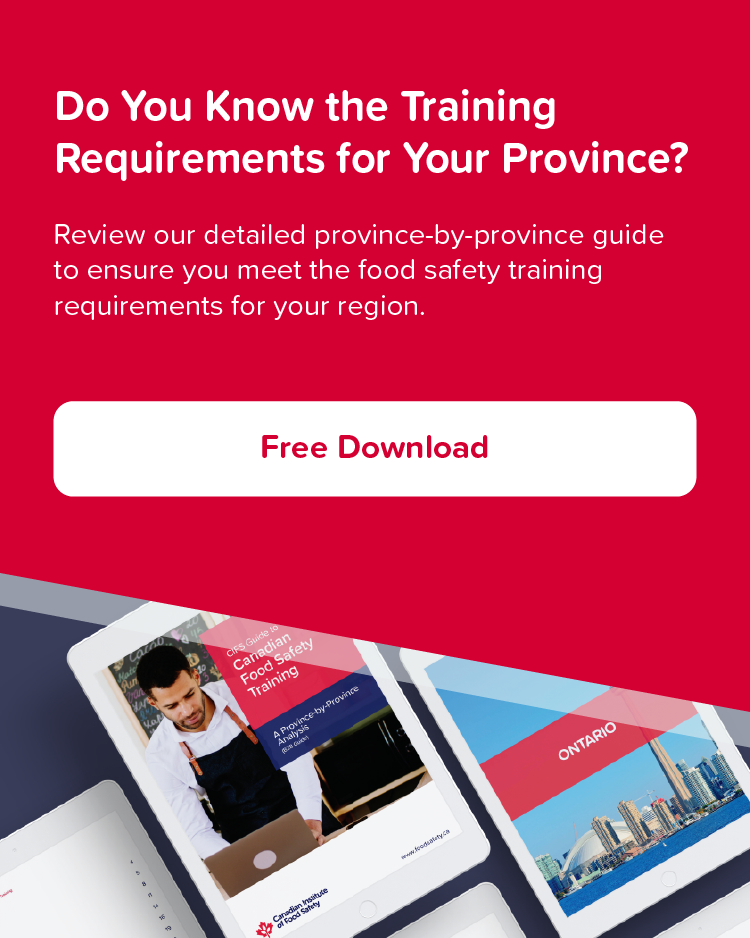
Restaurants and other food service establishments in Canada are subject to inspection by local Public Health Inspectors (PHIs), also referred to as Environmental Health Officers (EHOs), Health Inspectors or simply ‘Inspectors’.
Health inspections (‘food safety inspections’) are carried out to verify:
- Compliance with food safety laws, regulations and municipal bylaws
- Safe food handling practices are being followed in the facility
- Food that is prepared or sold in the facility is safe for human consumption
What are Health Inspectors allowed to do?
At any reasonable time, a Public Health Inspector (PHI) has the authority to enter any place or premises where food handling activities are being conducted; or where food products, equipment or relevant documentation is located. On-site inspections may be scheduled or unannounced.
By law, you must grant an Inspector access to enter all applicable areas of the site being inspected. It is illegal for anyone working in the facility to obstruct or knowingly make false or misleading statements to an Inspector while they are carrying out their duties.
In order to verify compliance with the relevant laws and regulations, the Inspector may:
- examine food products, ingredients or dishes
- open and examine any food storage container, receptacle or package
- take samples of products, ingredients or dishes for further analysis
- request food safety training records and documentation
- examine and make copies of documents, records, Food Handler Certificates or other records
- ask questions to anyone working on the premises
What are Health Inspectors looking for?
Health Inspectors will be checking for a number of criteria, but here are some of the main things they will be looking for:
- Potentially hazardous foods also called high-risk foods, are maintained at the required temperatures (e.g. cooked poultry is stored outside of the Temperature Danger Zone).
- Food is protected from contamination (e.g. food is stored or displayed in containers with tight-fitting lids).
- Food contact surfaces can be easily cleaned and sanitized (e.g. equipment is in good repair, suitable for the intended purpose and made of material that can be easily cleaned and sanitized).
- Good personal hygiene is being practiced by all employees (e.g. Food Handlers are wearing clean and appropriate work clothing and wash their hands whenever they are likely to have become contaminated).
- Efficient cleaning and sanitizing are being practiced (e.g. kitchen equipment, utensils and dishware are cleaned and sanitized after each use).
- Presence of a Certified Food Handler (e.g. there is at least one Food Handler or supervisor on site who has completed a nationally recognized food handling course).
Province-By-Province Food Safety Guide
How to prepare for a health inspection
If you’ve trained your staff in food safety and put safe food handling procedures in place, you’re unlikely to encounter many problems during your inspection. The best way to prepare for an inspection is to stay inspection-ready at all times.
In order to stay inspection-ready, be sure to do the following:
- Understand the law as it applies to your business (know your legal obligations).
- Ensure all food handling staff have the required food safety skills and knowledge.
- Make sure a percentage of your Food Handlers and managers have a food safety certificate*.
- Monitor food storage, preparation and cooking procedures (keep an eye out for food safety hazards).
- Conduct random self-inspections to get an idea of where you may be falling short.
- Review the results of recent inspections to ensure any previously identified violations have been corrected.
*Food safety training is mandatory and regulated in Canada, but the percentage of staff that are required to complete an official food handling course differs depending on the location of the business. To learn about food safety training requirements in your province or territory, visit our Laws and Requirements page and select your location.
What to do during a health inspection
All staff should be trained to alert the manager on duty when an Inspector arrives in the business. The manager on duty may ask whether the inspection is routine or if it was prompted by a customer complaint.
If the manager wishes to verify the Inspector's credentials, they may do so by calling their local health authority.
You may not (and should not) refuse an inspection, but you can accompany the Inspector as they walk through the facility. This gives you an opportunity to answer their questions and ask for advice or clarity about inspection results.






